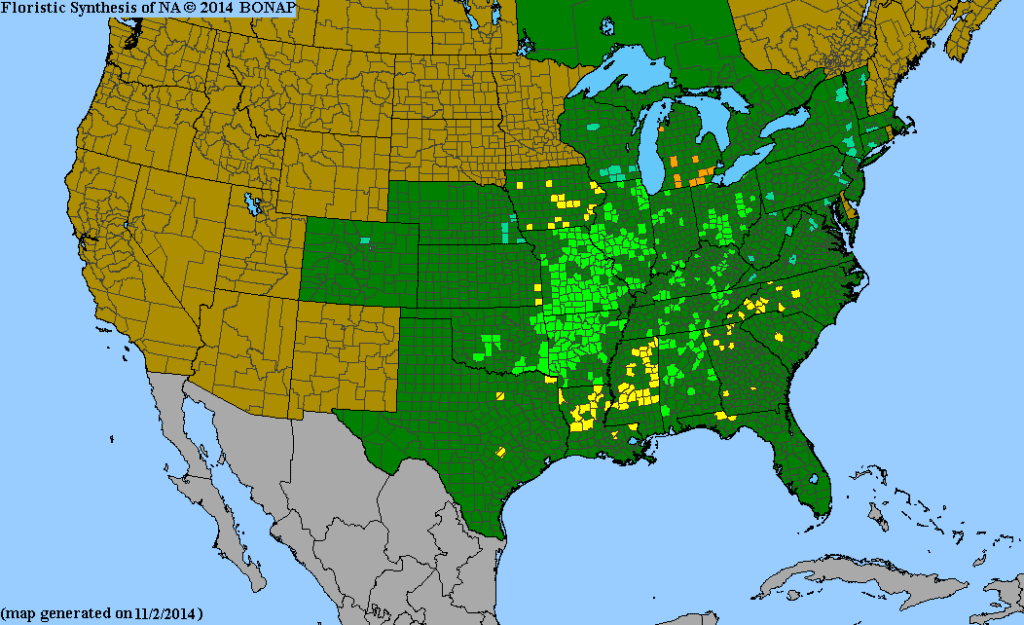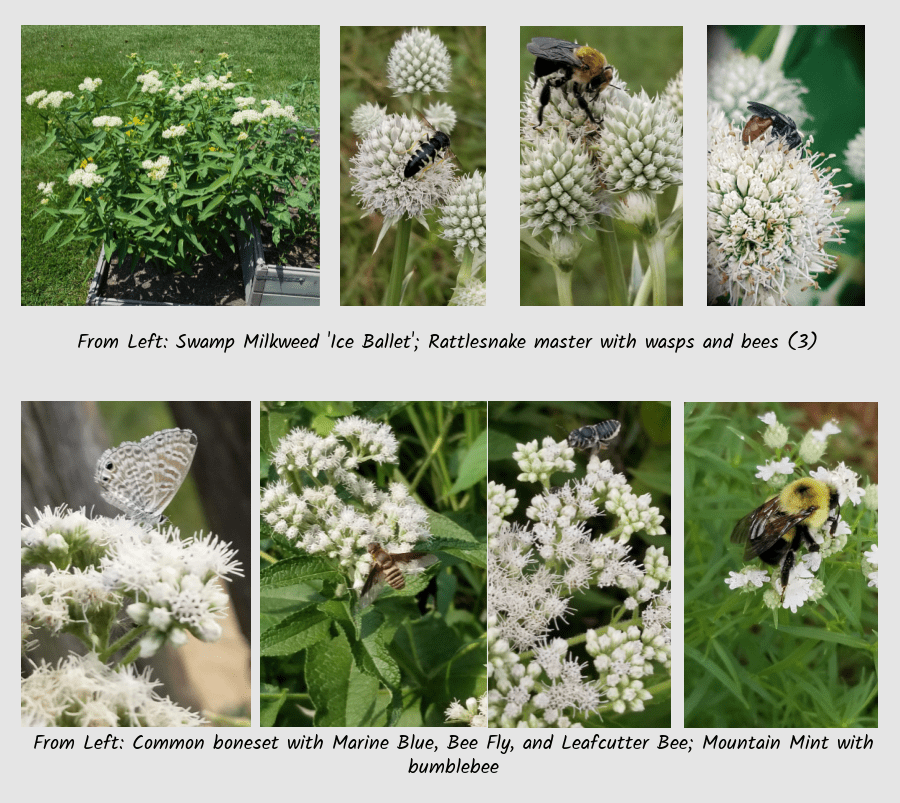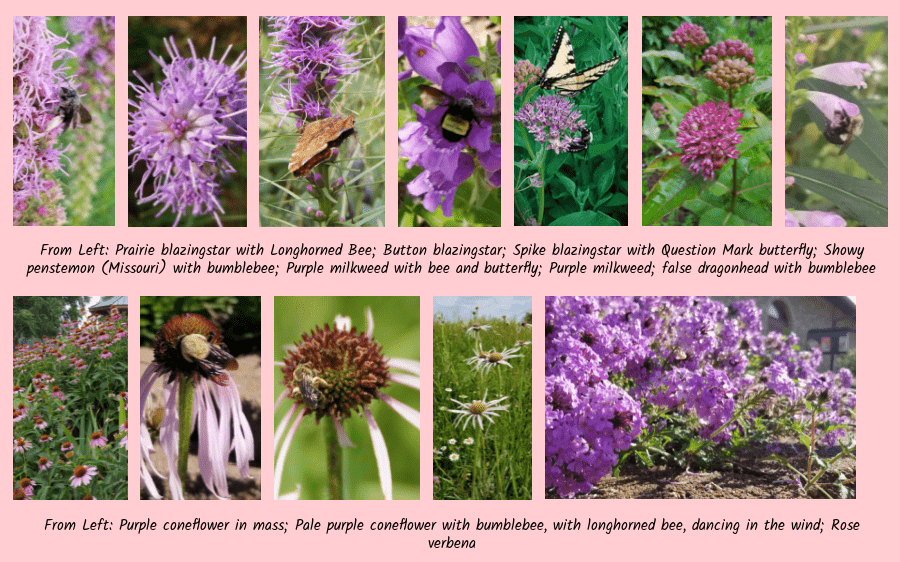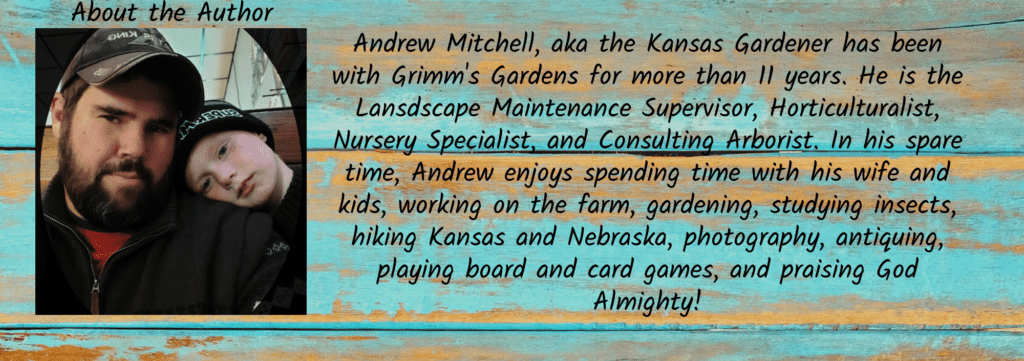How many favorite natives can you have? I have been gardening for more than 30 years, and adding natives into my gardens from the very beginning. At my parent’s home in North Central Kansas, I recognized several natives which made their way into my container gardens, and eventually into the landscaping I did for my parents.
What are natives? I recently had a coworker ask what native meant. Natives are plants which are found within a specific ecoregion, or larger region of a country or continent. These are specific plants within a genus. For example: Purple coneflower( Echinacea purpurea) can be found growing wild in North America, mainly in the Midwest (see map below). Native in a general sense can also include nativars, which are cultivars derived from native plants.

Now, some of my favorite natives may not be readily available at Grimm’s Gardens, or even your local nursery, but may be found by seed from regional seed sources. But not all my favorite natives are garden plants. So this is really a list of my favorite natives for the garden. I have a large garden area, nearly an acre in total size, and it keeps expanding. The percentage of native annual, perennial, shrub, vine, and tree is much greater than nonnative. But we are just going to focus on native annuals and perennials.
Favorite Natives for Shady Spots in My Garden
What you choose for the garden may be totally different than me. And that is okay. Gardeners do not need to agree on everything. I like my garden the way it is. we are just sharing ideas here.
Now, I live near an oak-hickory remnant forest in Northeastern Kansas, and there are some wonderfully shady spots around my house. I have large cottonwoods, oaks, hickory, black walnut, and Osage orange trees. Also, I have planted Kentucky coffeetree, ginkgo, redbud, seven son, and fruit trees. All of which create more shade for my landscape.
I have several areas, called by specific names to be gardens. The Woodland Border, Entry Garden, and Pawpaw Grove are all shady gardens. It is in these gardens where shade-loving annuals and perennials thrive. Besides natives, I also utilize hostas, coral bells, bulbs, and other shade loving favorites.
6 Natives for the Shade Garden
There are much more than 6 natives that can be grown successfully in he shade garden, I just have not tried them all yet. Give me time. I have actually planned to add American ginseng, twinleaf, and goldenseal into the Woodland Border in early 2022. These plants are both native and medicinal, and will be grown for both reasons.
- Wild ginger (Asarum canadense) – I planted this from a rooted division I got from work and it has developed a nice mat of heart-shaped leaves. As a groundcover, it is not very showy, and the flowers are hidden under the foliage, but it works well in dry, rocky areas of the garden.
- Virginia waterleaf (Hydrophyllum virginianum) – All I can say is be careful where you put it. This is perhaps the most aggressive groundcover in the garden, I would put it up against nonnative English ivy or vinca minor. Flowers are pink or white and very showy.
- Bloodroot (Sanguinea canadensis) – When I first discovered bloodroot on a wildflower walk, I was impressed with the white flowers and blood red juice of cut rhizomes. Adding it to the garden I discovered that it tolerate growing under black walnut ( a must in my garden).
- Woodland phlox (Phlox divaricata) – Perhaps on of my favorite natives of all, it is a great border plant for the shade garden, and the flowers can be white, blue, or pink.
- Red Columbine (Aquilegia canadensis) – At first, I disliked the weedy tendencies of columbine. But I have grown to love it after seeing the hummingbirds fly in to it in early spring.
- Shooting Star (Dodecatheon media) – Love at first sight. I saw shooting stars at an arboretum in Kansas City and said to myself “I have to get some”. And now I do.

Favorite Natives for Sunny Spots
I have a lot more sun than shade, at least north of my house. Here, the landscape opens up and it is where my Sunny Cottage Garden, Meadow Garden, and Potager Garden all take up room. It can be difficult to separate out the 37 or so favorite natives from my sunny gardens, so I will do so by flower colors.
Natives with White Flowers
Some of these are true natives, and some are nativars, selected for their unique flower colors. Enjoy the show!
- Rattlesnake master (Eryngium yuccafolium) – Most people I meet in the garden do not like this flower. But it is one of my all-time favorite natives. Large plants and yucca-like leaves give rise to tall, hollow flower stalks and globular white flowers. It attracts LOTS of pollinators.
- Swamp Milkweed ‘Ice Ballet’ – This is a cultivar of a regional selection of swamp milkweed, native to Minnesota. It is shorter than the Central Great Plains’ swamp milkweed, and it has white flowers instead of pink.
- Common boneset (Eupatorium perfoliatum) – With leaves that tightly attach to the stem, and white flower heads, what is not to like. Add in the fact that it can grow unplanted in a container in my potager for 2 years and it blooms for 8 weeks, what else do you need in late summer?
- Mountain Mints (Pycnanthemum species) – I now have 3 species of mountain mints in my garden: Virginia, Blunt, and Slender. They are all pollinator magnets which spread slowly in comparison to other mints, and they can still be used to make tea.

Natives with Orange Flowers
There are not a lot of plants period, with orange flowers. But the ones that do have it sure shine in the garden.
- Butterfly milkweed (Asclepias tuberosa) – Another of my all-time favorite natives, I have marveled at this plant growing in the Flint Hills, eastern Kansas, and even in my backyard. Besides attracting the Monarch butterfly, I love how many other pollinators come to it.
- False sunflower (Heliopsis helianthoides) – The color is much more orange than yellow to me, but others may call it yellow. Maybe it is golden. However, the flower petals fade to yellow and then tan, and the plant is quite at home in the Meadow Garden.
- Michigan Lily (Lilium michagense) – I had no idea lilies were native when I moved to Northeast Kansas. But I have found 5 different clumpings of this lily within Brown and Atchison counties, and I was unprepared for how jewel-like the blooms really are.
- Willowleaf Sunflower ‘First Light’ – The true native willowleaf sunflower is yellow-flowered, but this nativar has more golden orange petals than yellow. It is one of the last flowers to bloom in my garden, and does wonders for pollinators in my Meadow Garden.

Natives with Yellow Flowers
True yellow flowers. Not golden orange, but truly yellow flowers. From light to creamy yellow, many natives shine in the garden.
- Butterfly Milkweed ‘Hello Yellow’ – A cultivar of my favorite butterfly milkweed, this nativar has yellow flowers and is a very tidy plant.
- Greyhead Coneflower (Ratibida pinnata) – If you need a tall native for the garden, look here. With clumps of cutleaf foliage, the flowering stems grow 3 to 6 feet tall above. Yellow petals surround a brown head which turns grey, hence the name.
- Cutleaf Coneflower ‘Goldquelle’ – This rudbeckia species is a long time favorite of mine. I first saw it as the backdrop in my Grandmother Trost’s garden in North Central Kansas. The double flowers are truly spectacular on tall plants.
- Giant Coneflower (Rudbeckia maxima) – Who can grow rudbeckia without this one? The giant, silvery green leaves and huge flowers are a must in the garden.
- Sweet Coneflower (Rudbeckia subtomentosa ‘Henry Eilers’) – Without a doubt, another of my favorite natives. Found in Illinois by Henry Eilers, this black eyed Susan has quilled or rolled petals on a 5 foot tall, clumping plant.
- Little Black-Eyed Susan (Rudbeckia triloba) – Perhaps the longest blooming black-eyed Susan, it has small, 1 inch flowers that bloom from July to frost. It is biennial.

Favorite Natives with Pink Flowers
- Purple milkweed (Asclepias purpurascens) – Although it is called purple, the flowers are actually a dark pink shade. This is an early blooming milkweed, opening in April and May, and the whole plant disappears by July.
- Pale purple coneflower (Echinacea pallida) – There are many cultivars of coneflowers, but I prefer 2 native species over the rest. This one has narrow petals and a taller, floppier habit, but seems to dance in the breeze.
- Purple coneflower (Echinacea purpurea) – Again, another plant called purple, but is actually pink. I have never seen a true purple coneflower, they are either red, pink, yellow, white, or some mix of these colors. This one is best for massing.
- Prairie blazingstar (Liatris pycnostachya) – Blazingstars are my favorite natives as a group. They are one of the first flowers I learned to identify in the wild. This one is tall and the second species to bloom in the garden.
- Spike blazingstar (Liatris spicata) – There are cultivars of this species in white and pink, and it is the first to bloom in the garden, in July.
- Button blazingstar (Liatris aspera) – Perhaps the most interesting blazingstar, the flowers appear first as little buttons along the stem. Needs to be in full sun for best performance.
- False dragonhead (Physostegia angustifolia) – A great plant for rain gardens or wet swales, it is also called obedient plant because you can temporarily move the individual flowers to a new spot on the stem.
- Showy beardtongue (Penstemon cobaea) – If you get this plant from the Missouri ecoregion, the flowers will be purple; but from Kansas it is pink. The flowers are large and attractive to bumblebees.
- Rose verbena (Glandularia canadensis) – This has got to be the best groundcover for full sun! It grows 3 to 6 feet wide each year and blooms from May to October. And it only gets 6 inches tall!

Favorite Natives with Purple Flowers
Purple is my second favorite color, right after green. I think that is why I have always been a Kansas State Wildcat fan, when so many in my family like KU.
- Leavenworth eryngo (Eryngo leavenworthii) – If you have not tried this native annual in your garden yet, get some seeds this year. It looks like a thistle with small, purple pineapple-shaped flowers. Bees love it!
- Fremont’s clematis (Clematis fremontii) – Another one of my all-time favorite natives, this clematis is a bush-type, not vining. It grows 2 feet tall and wide and is covered with small, bell-shaped flowers in April and May, and sometimes reblooms in September.
- Aromatic aster ‘Raydon’s Favorite’ – When I came across this cultivar at a show, I had to add it to my collection. This is the last plant to bloom in my garden each fall, though it may start as early as August. It usually finishes blooming in November, even surviving hard freezes.
- New England Aster (Symphyotrichum novae-angliae) – The tallest aster in my garden, I have pink, purple, and mauve selections. In the ditch near my house, I have selected several pink blooming varieties which re-cross naturally.
- Letterman’s ironweed ‘Iron Butterfly’ – A recent addition to my garden, and a great one at that! It is short, growing only 2 feet tall. But the butterflies love it.
- Purple poppy mallow (Callirhoe involucrata) – This was the first native I used in containers, before I understood how it grew. It has a large edible storage root, and a great groundcover plant.
- Woolly verbena (Verbena stricta) – One of the longest living natives I know of. There is a plant at my Mom’s that is at least 38 years old, and still growing through the same crack in the driveway.

Baptisia for the Garden
One of my favorite native groups is baptisia, or false indigos. Over the years, I have collected 10 or more species and cultivars (nativars). They are long-lived, come in a wide range of colors, and make great cut flowers. Also, many butterflies and moths use them as a host plant. And I have seen bumblebees and butterflies pollinating them.
Following is a list of my favorite baptisias for the garden.
- Blue wild indigo (Baptisia australis) – grows native mainly in Kansas and Oklahoma. I have seen many wild plants which could be selected for nativars.
- White wild indigo (Baptisia alba) – Another native species, but with a much wider range. It usually only sends up a couple of flower spikes per plant.
- ‘Pink Lemonade’ – This cultivar has flower spikes of pink and yellow. It is simply a must-have in the garden.
- ‘Lunar Eclipse’ – Another great nativar, this variety has flower spikes of white and purple. This is a must-have for Kansas State wildcat fans.
- ‘Cherries Jubilee’ – The name makes you hungry huh? The flower spikes are red tinged with yellow.
- ‘Sparkling Sapphires’ – It has dark blue-purple flower spikes.
- Twilite ‘Prairieblues’ – This was my first baptisia cultivar, and it has moved twice since purchase. The one I have is now 12 years old and counting. The flower spikes are purple-brown with yellow highlights.

Favorite Native Grasses
Not mentioned above are any of the grasses that I have in my garden. I love native grasses, and I do not have nearly enough of them. I especially love switchgrasses and big bluestems. Grasses are important parts of every healthy ecosystem, even sedges in the shade. The prairie grasses are very well-known when coming to the Flint Hills.
- Switchgrass ‘Shenandoah’ – The best small switchgrass with red-green leaf blades all summer. I like to plant it in masses in my garden beds.
- Switchgrass ‘Dallas Blues’ – This is the largest switchgrass for the garden, growing 9 feet tall. The leaves are blue-green in color.
- Switchgrass ‘Northwind’ – A very upright selection; it grows 4 to 6 feet tall with dark green leaves.
- Little Bluestem ‘Standing Ovation’ – If you check out my selections, you will find I like native grasses which do not flop in the garden.
- Prairie dropseed – A native grass with an open, spreading habit, and airy flower stems. It grows only 2 feet tall and wide.
- Big bluestem (Andropogon gerardii) – Also called turkey foot, the seedheads form a 3 part “foot-like” shape. I have seen specimens grow 9 feet tall.
- Big bluestem ‘Blackhawks’ – A dark purple leaved selection, it adds great interest to the garden.
- Indiangrass (Sorghastrum nutans) – There are some exciting selections coming for this feathery seeded grass. I am looking forward to trying ‘Golden Sunset’ in my garden soon.
- Fox sedge (Carex vulpinoidea) – This sedge is great for streambanks, rain gardens, and edges of meadows.
- Bottlebrush sedge (Carex hystericina) – Another sedge for the rain garden, or meadow edges.
- White-tinged sedge (Carex albicans) – A sedge for the shade, this one grows 1 foot tall and wide.

Pollinators of My Favorite Natives
The main reason, besides how awesome these plants look, for growing natives, is for pollinators. I love that native species host a wide range of butterflies, moths, and other insects, which in turn attract birds, reptiles, amphibians, and mammals to my garden. Let us look at each individual section of my favorite natives, for their pollinator potential.
- Shady Natives – Of the 6 species I have listed, together they host 1 butterfly, 3 moths, and a variety of other insects including leaf beetles, aphids, sawflies, and leaf miners. All of these are part of a diverse ecosystem of animals.
- White Flowered Natives – Between these 4 species in my garden, most of the host plant work goes to the milkweed and boneset. They all combine to host 1 butterfly, 10 moths, beetles, bugs, aphids, grasshoppers, katydids, leaf miners, and weevils.
- Orange Flowered Natives – The numbers begin to increase. Between these species of plants, 4 butterflies, 11 moths, beetles, bugs, katydids, and aphids make up the insects needing them for a host plant.
- Yellow Flowered Natives – Mostly rudbeckias, these natives play host to 3 butterflies, 13 moths, and a variety of bugs, beetles, katydids, aphids, and sawflies.
- Pink Flowered Natives – While these plants are certainly visited by many bees, butterflies, and other pollinators, they only play host to 2 butterflies, 7 moths, aphids, beetles, and bugs.
- Purple Flowered Natives – Among these plants, the majority of host power goes to asters. Between them all, there is the potential to host 2 butterflies, 48 moths, thrips, midges, aphids, and grasshoppers.
- Baptisias – Just these play host to 6 butterflies, 3 moths, weevils, beetles, bugs, and thrips.
- Grasses and Sedges – If you want skipper butterflies, plant grasses and sedges. They are hosts to 18 skipper butterflies, 8 moths, grasshoppers, katydids, thrips, aphids, leafhoppers, beetles, flies, and bugs.
Conclusion
Adding any of my favorite natives to your garden, if you live in the Central Great Plains, will increase your biodiversity. Native perennials and annuals, and their nativars will increase pollinators, birds, and overall wildlife potential of the garden. I try to use as many natives as possible when adding to different areas of my garden. And I hope you do too.
Happy planting!





What a wonderful way to enjoy ones life, working your land with your family and enjoying the nature that surrounds you. I loved your assesment of the many plants you grow both native and nativars, especially that you have named the polinators that need them to survive.
Thanks for a nice read and your efforts to save the pollinators ..
Linda
New Jersey